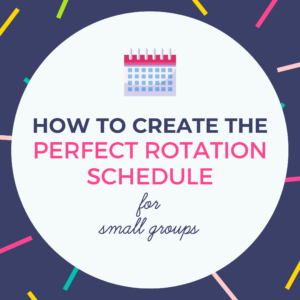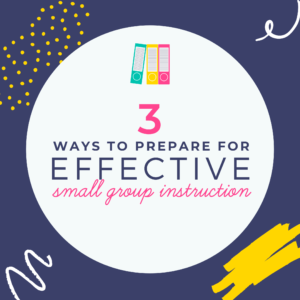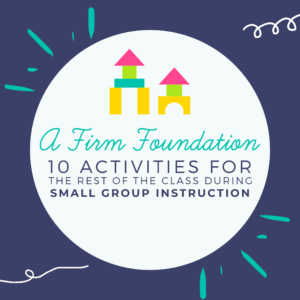Finding Time for Small Groups
We’ve been hearing it a lot lately, and I’m sure you’ve thought it too… “I don’t know how to fit it all in!!” We all want to make the use of every minute we have with our students, and yet, at the end of the day you may be scratching your head and wondering where your time went. We know reading small groups and math small groups are equally important. Kids need that more individualized and focused instruction. We know RtI small groups are important. Again, we want to bring up every below grade level student in our care and stretch every above grade level student. Prioritizing whole class instruction is an obvious must. The kids need to go to specials. We’ve got to feed them at some point. How do we do it all?!
Your daily schedule can make or break your days, and if your schedule isn’t totally making your day yet, we want to help! Creating the perfect schedule that allows for all the things including teaching, reading small groups, math small groups, RtI groups, etc. is hard work! Especially when you have time constraints like lunch, recess, and specials to work around. But, we promise you, you can do it!
The Key to Finding Time for RtI, Math, and Reading Small Groups
Flexibility! Flexibility as a teacher is an absolute must. If you aren’t flexible yet, start stretching!! You will never be able to fit in your math and reading small groups, not to mention RtI small groups, if you can’t find some wiggle room in your schedule. Keep an open mind and consider implementing a new schedule. It doesn’t matter if you are reading this in August, December, or even April. It is never too late to try improving your schedule.
Study Your Current Schedule

The first thing you want to do is assess your current schedule. Print out the schedule planner below (or make your own), grab your favorite pens, and get comfy! Write down your current schedule exactly the way it is. Don’t try fixing anything yet, and be honest!! You’ll find this free printable and a corresponding checklist at the end of the post to help you find time in your schedule to comfortably fit in all your teaching and small group responsibilities! Once you have your current schedule written out, you can begin analyzing it and constructing a new one. Remember flexibility is key!!
Draft a New Plan to Account for Small Groups

Now that you have your current schedule in front of you, let’s make a new one! We want to make sure you have time for everything you consider important so that you can go home at the end of the day feeling proud of all that you were able to accomplish with your students during the day.
First, add anything that cannot change to the new schedule. These would be things like your start and end times, lunch and recess times, when your students go to specials, etc.

Start Teaching When the Bell Rings
Next, take a look at the way you currently start your day. Are you waiting until the morning bell to take attendance and lunch count, collect notes and papers that have been sent back, begin morning work, etc.? This is a major time drain! If you want to have ample time for reading small groups, math small groups, RtI groups, etc. in addition to your regular teaching, you need to take care of all housekeeping items and morning work BEFORE the bell rings!
We always tell our students that the bell tells us when to start teaching- not when to get settled in to begin the day! Of course every school is different, but at our building, students are sent to the classroom, 20 minutes before the start bell. That is more than enough time to complete morning work, collect notes and papers, make sure everyone has been to the restroom, and complete your attendance and lunch count before the bell rings. Make sure both you and your students are ready for teaching as soon as the bell rings! This is an automatic and easy addition into your time bank for the day if you aren’t already doing this.
Another often overlooked time of day is after the dismissal bell. At our school there is always about 15-20 minutes between the time when our parent pickups leave and when the bus riders leave. We like to use this time to help prepare for the next day. Kids would help sharpen pencils, distribute papers, etc. This can save you time in the morning!
Utilize Your Uninterrupted Time
The next thing you need to add to your new schedule is your main teaching time. Look for your largest chunks of uninterrupted time. Utilize these larger blocks of time for your math and reading instruction. This is where you will want to have the most continuous flow of time to allow for uninterrupted learning. While you are scheduling your math and reading time think about where you will fit in your math and reading small groups. You will also want to consider any minimum math and ELA time requirements you have from your district.
Fill in the Gaps
Finally, fill in all gaps in your schedule. This is when you will add your science, social studies, handwriting, etc. Consider your RtI requirements and add time for those groups as well. Make sure you account for every minute of your day. Just like you want to account for every dollar in your monthly budget, you want to account for every minute in your school day. If you don’t tell each minute where it belongs, it will slip away into the abyss, and you’ll be left wondering where it went.

Always Account for Transitions
In making sure you tell every minute of the day where it belongs, you need to consider your transitions. Look for the sweet spot of enough time to not be chaotically rushing, but also not wasting time. For us, five minutes was always a perfect amount of time to line up, use the restroom, and travel to our specials. It gave us enough time to calmly carry out this routine. And, at the same time, it was a little enough amount of time that students needed to get in, get out, and move on to make it to specials on time. We accounted for the same five minute transition upon returning to the classroom as well. Don’t let your day be eaten up by unnecessarily long transitions!
A Final Reminder
Ten minutes is ten minutes – don’t waste it! Ten minutes here and 10 minutes there add up and turn into 20-30 minutes that could have been used for an RtI, math, or reading small group. Take a little time to also consider what you will do in the event that a lesson or transition doesn’t take as long as you had planned. What can you do to fill unexpected 2, 5, 10 minute gaps of time? Don’t give this time away to free time, chat with a neighbor time, drawing time, etc. How can you fill this time in a productive and educational manner? Do you have time for a quick review game, a few minutes of independent reading, a class read aloud? Remember to be flexible and prepared!
If you are looking for more small group resources, check out the following posts:
- How to Organize Your Small Groups
- Read this post if you need ideas for the rest of the class while you’re working with small groups!










2 Responses
Thank you for another wonderful blog! This is great for starting our new semester.
Thank you, Michelle! We hope you have a great week!